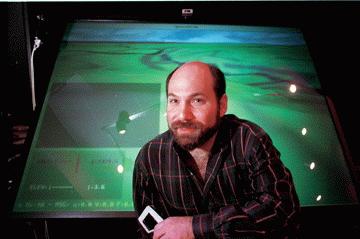
Gridmaster Carl Kesselman’s partnership with Argonne-Chicago’s Ian Foster has won triple recognition in recent weeks.
ISI will share as a major partner in a $12.1 million National Science Foundation grant to develop new ways of sharing one-of-kind scientific instruments, data, and programs. NSF announced the award Monday, September 24.
The grant is the third important recent endorsement of so-called “grid” software and tools developed by the Globus Project, an effort led by Carl Kesselman, a research associate professor of computer science at USC who is director of ISI’s Center for Grid Technologies; and Ian Foster, who holds joint appointments as a professor of Computer Science at the University of Chicago and as Senior Scientist at Argonne National Laboratory.Kesselman described what this NSF grant is working toward:
“Consider a professor teaching a class in environmental engineering, who wants his students to gets hands-on experience with environmental monitoring and modeling. The technologies that we will deploy for authentication, resource discovery, and so forth will make it possible for these students to call upon national resources as they undertake class projects.”
ISI and Chicago will each receive approximately $2.1 million of the NSF award announced today, with the balance going to other partners, including the National Center for Supercomputing Applications. Kesselman, Foster, and NCSA Network Development Group Leader Randy Butler will head the software development effort, which will be based on Globus’s beginnings in the field.
NSF Program Director Alan Blatecky reached back to the beginnings of the Internet to convey the scope and implications of the project, known as the “National Middleware Initiative.” (Middleware is software that connects two or more otherwise separate applications)
“Much as the NSFnet network, established in 1985 laid the groundwork for the dramatic success of the Internet, we expect this NSF Middleware Initiative to lay foundations for the Grid, and spur adoption of the advanced services that will define the networks and distributed systems of tomorrow.”
The award is the third major endorsement in recent weeks of the Globus approach, which began as a way to allow raw computing power to be distributed and shared instantly and easily, just as electrical energy is through a power grid, and has developed into means to effectively share unique instruments, databases, and programs beyond the capacity of the existing Internet.
* On August 2, IBM Corporation announced a large-scale effort to support what its announcement called a “revolutionary new open-source based computing model that IBM sees as a critical next step in the evolution of the Internet. … In the same way it played a leadership role in the commercial adoption of Linux, IBM will work with ‘Globus’ and related open source development communities….”
* On August 27, the NSF announced a $10 million grant to create a national virtual “collaboratory” to share equipment, data and research tools to help engineers create better techniques to safeguard structures against earthquakes. This NCSA-led effort to build a National Network for Earthquake Engineering Simulation, or NEESGrid, will incorporate Globus technology, and have the Globus partners as co-investigators.
The National Middleware Initiative (NMI) effort will be in two sections. A Grids Research Integration Deployment and Support (GRIDS) Center led by Kesselman, Foster and Butler will include ISI, Chicago, and NCSA, along with the University of California at San Diego (UCSD) and the University of Wisconsin at Madison. GRIDS will create the basic suite of software (or “middleware”).
A second group will be made up of three partners: the Internet2 consortium, consisting of some 180 universities “working in partnership with industry and government to develop and deploy advanced network applications and technologies;” EDUCAUSE, “a nonprofit membership association aimed at the advancement of higher education through the promotion of the intelligent use of information technology,” and the Southeastern Universities Research Association (SURA).
This second group, led by Internet2, will create necessary end-user utilities, and promote rapid and wide deployment of the grid technologies to the higher education and research communities.
Published on September 26th, 2001
Last updated on August 10th, 2021













